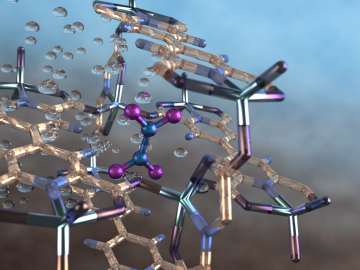
Filter News
Area of Research
- (-) Energy Science (164)
- (-) National Security (21)
- (-) Supercomputing (84)
- Advanced Manufacturing (6)
- Biology and Environment (126)
- Biology and Soft Matter (1)
- Building Technologies (2)
- Computational Biology (1)
- Computational Engineering (3)
- Computer Science (9)
- Electricity and Smart Grid (1)
- Energy Sciences (2)
- Functional Materials for Energy (2)
- Fusion and Fission (8)
- Fusion Energy (1)
- Isotopes (2)
- Materials (80)
- Materials for Computing (11)
- Mathematics (1)
- Neutron Science (25)
- Nuclear Science and Technology (6)
- Quantum information Science (2)
News Topics
- (-) Energy Storage (74)
- (-) Environment (73)
- (-) Machine Learning (28)
- (-) Mercury (3)
- (-) Microscopy (14)
- (-) Molten Salt (1)
- (-) Summit (44)
- 3-D Printing/Advanced Manufacturing (83)
- Advanced Reactors (8)
- Artificial Intelligence (50)
- Big Data (30)
- Bioenergy (31)
- Biology (22)
- Biomedical (22)
- Biotechnology (7)
- Buildings (39)
- Chemical Sciences (16)
- Clean Water (8)
- Composites (17)
- Computer Science (116)
- Coronavirus (27)
- Critical Materials (12)
- Cybersecurity (28)
- Exascale Computing (27)
- Fossil Energy (2)
- Frontier (32)
- Fusion (3)
- Grid (45)
- High-Performance Computing (46)
- Hydropower (3)
- Isotopes (2)
- Materials (46)
- Materials Science (41)
- Mathematics (4)
- Microelectronics (1)
- Nanotechnology (15)
- National Security (38)
- Neutron Science (22)
- Nuclear Energy (14)
- Partnerships (16)
- Physics (9)
- Polymers (13)
- Quantum Computing (20)
- Quantum Science (27)
- Security (18)
- Simulation (18)
- Software (1)
- Space Exploration (6)
- Statistics (1)
- Transportation (72)
Media Contacts

An international team of researchers has discovered the hydrogen atoms in a metal hydride material are much more tightly spaced than had been predicted for decades — a feature that could possibly facilitate superconductivity at or near room temperature and pressure.

The formation of lithium dendrites is still a mystery, but materials engineers study the conditions that enable dendrites and how to stop them.

Oak Ridge National Laboratory researchers created a geothermal energy storage system that could reduce peak electricity demand up to 37% in homes while helping balance grid operations.

To better determine the potential energy cost savings among connected homes, researchers at Oak Ridge National Laboratory developed a computer simulation to more accurately compare energy use on similar weather days.

Researchers across the scientific spectrum crave data, as it is essential to understanding the natural world and, by extension, accelerating scientific progress.

For nearly three decades, scientists and engineers across the globe have worked on the Square Kilometre Array (SKA), a project focused on designing and building the world’s largest radio telescope. Although the SKA will collect enormous amounts of precise astronomical data in record time, scientific breakthroughs will only be possible with systems able to efficiently process that data.

A technology developed at the ORNL and scaled up by Vertimass LLC to convert ethanol into fuels suitable for aviation, shipping and other heavy-duty applications can be price-competitive with conventional fuels

An international team of scientists, led by the University of Manchester, has developed a metal-organic framework, or MOF, material

Students often participate in internships and receive formal training in their chosen career fields during college, but some pursue professional development opportunities even earlier.

The U.S. Department of Energy’s Office of Science announced allocations of supercomputer access to 47 science projects for 2020.


